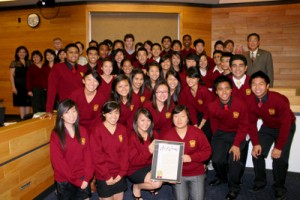
Cerritos MUN students pose after being honored by the Cerritos City Council for their achievements. Cerritos High School in Southern California offers Model UN as a class.
The Best Delegate team and I have seen hundreds of MUN clubs in action around the world, first as delegates, then as conference organizers, and now as professionals.
Every club has a different story, but they share common themes and go through similar stages. Also, the educational benefits of Model UN (which I described in my previous post) increase with each stage.
In this post, I’d like to show high school students and teachers who are new to Model UN a potential path that your MUN club can follow – and what is possible with MUN. But here are the main takeaways:
- At their most essential, Model UN clubs do two things: attend conferences and run conferences. New clubs should focus on sustainability — being able to attend and run conferences year after year.
- Model UN clubs can do more than attend and run conferences. Model UN can be offered as a class, become a flagship program that adds prestige to your school, and even form as an education non-profit that can offer scholarships to your students.
- The most important factor in the long-term growth of a high school Model UN club is the advisor. Students have to take initiative in terms of starting the club and running conferences, but they graduate. Only the advisor has the institutional knowledge necessary for a Model UN club to keep growing and learn from previous years. Conversely, Model UN clubs can disappear if the advisor leaves and, due to lack of institutional knowledge and documentation, no one can take that advisor’s place.
Start a Model UN Club
Model UN is a club at most schools across the United States. Many clubs focus on attending one or two large overnight conferences a year, which are great experiences, but they are costly, require extensive planning, and are often highly competitive (which tends to overwhelm newer delegates). More clubs should attend multiple local 1-day conferences, ideally in the Fall, in order to gain experience and prepare for the larger overnight conferences.
Start a Model UN Conference
Most MUN clubs attend conferences only and stop there, but they should consider starting their own conference. Running a conference is not only a great educational experience for students, it serves as a fundraiser (you can charge a low registration fee) and provides publicity for your MUN club (you can invite students from your school who are not in the club to participate as delegates). Serving as chairs also make students better delegates. And as more clubs start hosting small conferences, neighboring school gain more chances to develop MUN experience, and everyone gets better at Model UN.
When starting your first conference, start small, keep it simple, and make it as easy as possible on your club. Run just one committee and invite only students from your school. You want to figure out event logistics, gain chairing experience, and prove to your club and your school administration that you can run a small event successfully. Once you’re familiar with running a conference, then you can expand by adding committees, inviting other schools, and increasing the number of delegates.
Offer Model UN as a Class
The most well-established Model UN clubs I’ve seen don’t call themselves clubs – they’re “programs,” in the same way that high schools have a football program or a drama program. Such programs offer MUN as a class, typically using Model UN to teach a social studies curriculum.
I come from a high school Model UN program that involves over 200 students and 3 advisors, and there are several similarly-sized MUN programs throughout Southern California. At these programs, MUN is incorporated into honors history, Advanced Placement, and International Baccalaureate classes for freshmen through seniors. Participation at conferences is factored into grades. These programs also run conferences that rival most college-run conferences, attracting 1,500+ delegates from around the world with highly experienced chairs (students of these MUN programs gain tons of experience by attending each other’s conferences).
These Model UN programs become highly valuable to their schools. Winning delegation awards and running conferences add to their schools’ prestige. A flagship Model UN program also attracts students who would otherwise attend neighboring schools. I’ve met parents who transferred their child out of their normally assigned school or district in order to get into a school with similar academic and athletic programs, but that also has a strong Model UN program. And when a Model UN program gets to this level, the Model UN advisor becomes indispensable to the school.
Form an Education Non-Profit
The most well-established Model UN programs feature a parent booster club that is formed as an educational non-profit organization. Their finances are independent from the school and profits generated by running conferences go into a separate bank account, which the program can then use to finance travel to other conferences. This is particularly helpful when it comes to planning travel to overnight conferences, especially international conferences – the booster club can put down the deposits for airfare and accommodations, lock in a specific price, and offer students a payment schedule.
Highly successful programs can also provide resources for their students, such as new computers and educational materials. They can also offer scholarships to help students finance travel to MUN conferences, and even scholarships to attend college.
* * *
The goal of this post is to provide new advisors and delegates with a different perspective on how they can build their MUN club. I’d love to get your thoughts and questions, as well as any advice that experienced Model UN teachers might have for those who are just starting out. Leave a comment below!

